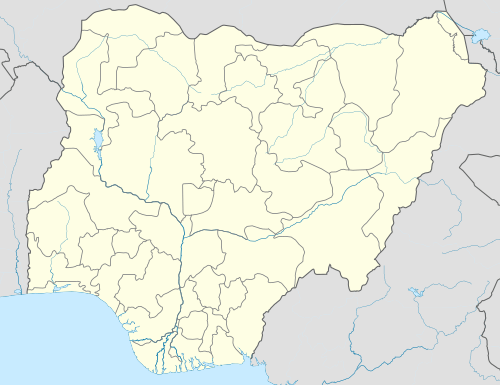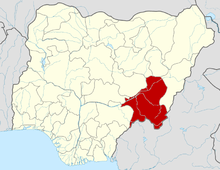Ibi, Nigeria
Ibi is a town and administrative district in Taraba State, Nigeria. The town is located on the south bank of the Benue River, opposite the influx of the much smaller Shemankar River. Both the Taraba River and the Donga River flow into the Benue within the LGA.
Ibi | |
|---|---|
LGA and town | |
 Ibi Location in Nigeria | |
| Coordinates: 8°19′N 9°51′E | |
| Country | |
| State | Taraba State |
| Local Government Headquarters | Ibi Town |
| Government | |
| • Local Government Chairman and the Head of the Local Government Council | Adashos J. Adashos |
| Area | |
| • Total | 2,672 km2 (1,032 sq mi) |
| Population (2006 census) | |
| • Total | 84,054 |
| Time zone | UTC+1 (WAT) |
| 3-digit postal code prefix | 620 |
| ISO 3166 code | NG.TA.IB |
Ibi is one of the sixteen local government areas of Taraba State, and is governed by an elected chairman.
History
Ibi was located where the traditional land trade route of eastern Igboland crossed the river trade route of the Benue River.[1] It was part of the Jukon kingdom (1720-1815) whose capital, Kororofa, was 35 miles east (up river).[2] After the Fulani invasion Ibi became part of the Muri Emirate (1817-1892).[2] Like the rest of Muri it was under the French governor Louis Mizon from 1892-1893.
By 1899 the Niger Company established a trading station at Ibi, and by 1901 telegraph service to Lokoja had been established.[3] The British took control in 1900 and established Ibi as the administrative headquarters of western Muri. As cotton was one of the major crops of the area, steam powered cotton gins were established in Ibi in the early 1920s.[4]
The Nwonyo fishing festival is one of the major festivities in the area.
Climate
| Climate data for Ibi, Nigeria | |||||||||||||
|---|---|---|---|---|---|---|---|---|---|---|---|---|---|
| Month | Jan | Feb | Mar | Apr | May | Jun | Jul | Aug | Sep | Oct | Nov | Dec | Year |
| Record high °C (°F) | 38.5 (101.3) |
40.5 (104.9) |
41.0 (105.8) |
39.5 (103.1) |
38.5 (101.3) |
34.5 (94.1) |
33.0 (91.4) |
33.5 (92.3) |
33.5 (92.3) |
35.0 (95.0) |
36.0 (96.8) |
36.5 (97.7) |
41.0 (105.8) |
| Average high °C (°F) | 35.0 (95.0) |
36.7 (98.1) |
37.1 (98.8) |
35.5 (95.9) |
32.5 (90.5) |
30.9 (87.6) |
30.0 (86.0) |
29.8 (85.6) |
30.5 (86.9) |
31.3 (88.3) |
33.4 (92.1) |
33.9 (93.0) |
33.1 (91.6) |
| Daily mean °C (°F) | 26.8 (80.2) |
28.6 (83.5) |
30.6 (87.1) |
30.0 (86.0) |
26.8 (80.2) |
26.6 (79.9) |
26.0 (78.8) |
26.0 (78.8) |
26.3 (79.3) |
26.7 (80.1) |
27.0 (80.6) |
25.8 (78.4) |
27.4 (81.3) |
| Average low °C (°F) | 18.5 (65.3) |
20.5 (68.9) |
24.2 (75.6) |
24.4 (75.9) |
23.1 (73.6) |
22.2 (72.0) |
22.1 (71.8) |
22.3 (72.1) |
22.1 (71.8) |
22.1 (71.8) |
20.7 (69.3) |
17.8 (64.0) |
21.7 (71.1) |
| Record low °C (°F) | 13.0 (55.4) |
13.5 (56.3) |
16.5 (61.7) |
19.5 (67.1) |
20.0 (68.0) |
19.5 (67.1) |
19.5 (67.1) |
19.5 (67.1) |
19.5 (67.1) |
18.5 (65.3) |
14.0 (57.2) |
11.0 (51.8) |
11.0 (51.8) |
| Average precipitation mm (inches) | 1 (0.0) |
2 (0.1) |
28 (1.1) |
96 (3.8) |
163 (6.4) |
193 (7.6) |
131 (5.2) |
137 (5.4) |
226 (8.9) |
138 (5.4) |
9 (0.4) |
7 (0.3) |
1,131 (44.5) |
| Average precipitation days (≥ 0.3 mm) | 0 | 0 | 1 | 4 | 9 | 11 | 11 | 12 | 14 | 9 | 1 | 0 | 72 |
| Average relative humidity (%) (at 07:00 LST) | 62 | 64 | 76 | 85 | 92 | 95 | 94 | 95 | 95 | 95 | 93 | 77 | 85 |
| Mean monthly sunshine hours | 260.4 | 259.9 | 251.1 | 219.0 | 238.7 | 195.0 | 173.6 | 155.0 | 177.0 | 244.9 | 270.0 | 282.1 | 2,726.7 |
| Mean daily sunshine hours | 8.4 | 9.2 | 8.1 | 7.3 | 7.7 | 6.5 | 5.6 | 5.0 | 5.9 | 7.9 | 9.0 | 9.1 | 7.5 |
| Source: Deutscher Wetterdienst[5] | |||||||||||||
Notes
- Afigbo, A. E. (1997) "Southeastern Nigeria, the Niger-Benue Confluence, and the Benue in the Precolonial Period: Some Issues of Historiography" History in Africa 24: pp. 1-8, p.4
- Duggan, E. de C. (1932) "Notes on the Munshi ("Tivi") Tribe of Northern Nigeria: Some Historical Outlines" Journal of the Royal African Society 31(123): pp. 173-182, p.173-174
- Arnott, D. W. (1958) "Councils and Courts among the Tiv--Traditional Concepts and Alien Institutions in a Non-Moslem Tribe of Northern Nigeria" Journal of African Law 2(1): pp. 19-25, p. 19
- Duggan, E. de C. (1922) "The Cotton Growing Industry of Nigeria" African Affairs 21(83): pp. 199-207, p. 203
- "Klimatafel von Ibi / Nigeria" (PDF). Baseline climate means (1961-1990) from stations all over the world (in German). Deutscher Wetterdienst. Retrieved 10 August 2016.
